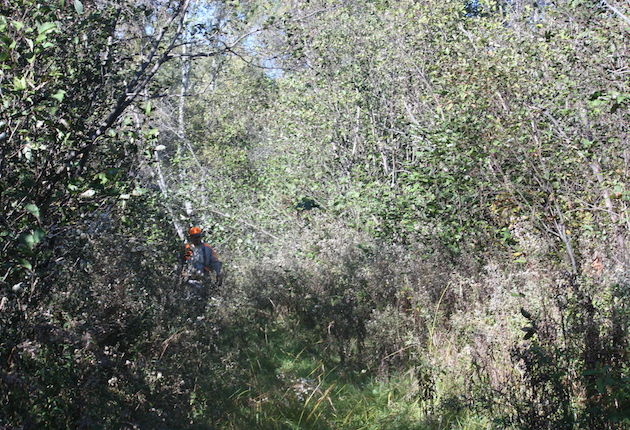How thrilling it is when we have a brand-new woodcock cover to explore. Maybe it’s something you stumbled upon while fishing a new stream or hunting mushrooms. Or maybe it’s a new cover you helped create with other volunteers with the same passion. Either way, there it is: acres of soft, moist ground protected by very dense, sun-loving cover. Alder, hawthorne, birch, and poplar dotted by the occasional old bull pine.
When the season finally arrives, it’s no surprise how quickly your dog gets “birdy” and the game begins. You look for a hole in the dense cover where you can get a clear shot at the quick-flying timberdoodle, only to have a pine soak up your shot pattern and the bird escape unscathed. Now those adjectives used to describe the new covert are replaced with colorful expletives.
It’s hard not to be overly aware of the trees and obstacles created by dense cover. Unfortunately, this distraction has evolved into a method of “poke and hope”—a quick snapshot is taken when the blur presents itself in that narrow lane the shooter is focused on. This is a low-percentage shot, and with woodcock we need all the help we can get.
There is a better method—it’s called, “There are no trees.”
Now, I haven’t gone completely mad. I understand that if you were to walk through a covert with that thought, you are going to bust your head on a big poplar or tangle up in the middle of a wild rose patch. As in the past, a path is carefully selected. When stopping, do so with the shooting foot forward in a closet-size clearing, giving just enough room to move, mount, and shoot. But when the bird flushes, it all disappears.
We have two types of vision; one is a smaller percentage of our vision as a whole, but it is clear, sharp, and with intense focus. This needs to be used to see nothing but the bird. If it is used, instead, to find the gap in the cover, then we fall back to the poke-and-hope method, with a clear picture of a hole in the cover that a blur just blew through.

“There are no trees. There are no trees. There are no trees.”
The other, much larger part of our vision is our peripheral, or subconscious awareness vision. This is what we use to keep a visual awareness of the yellow line when driving. The smaller, more focused vision is used to watch the car ahead of us (or to look at the edges of the fields for more bird cover). Your subconscious vision will easily let you know of a good opportunity while you maintain strong focus on the bird.
Once you learn to tune out the dense cover and turn up the intense focus on the bird, you can apply the same technique that is used when practicing on targets in the open. The forehand points and follows the glimpses of the bird, developing a flight line. The gun-mount hand follows suit and starts to slide the gun to the cheek. When it all comes together, you squeeze the trigger, win or lose.
There will be times that the timing of firing the gun and the woodcock going behind a tree are unfortunately perfect. But what will surprise you is how consistently your Lab brings back a dead woodcock. The fact that the muzzle is drawing the bird’s flight path when fired and that your shot pattern is stringing out slightly allows the possibility for the bird to run into the tail end of the string.
A great way to prepare for the distractions of thick-cover hunting is to start out in the open with a clay thrower and your hunting buddy. Work on the typical angles and distances common to woodcock coverts, then challenge your focus by moving into the woods, throwing the same angles and distances. Practice seeing the target with the same clarity, regardless of the obstacles.
The mental practice of “tuning out” is very common in all sports. The discipline it takes to eliminate distractions for a basketball player shooting free throws or a baseball batter at an away game in a full stadium is practiced as much as the technique. Remember, “There are no trees.”
Lars Jacob has been teaching the fine art of wingshooting for more than 30 years. He is currently the Director of Shooting for Covey and Nye and the prestigious Dutch River Club. In addition to instruction, Jacob is recognized as one of the country’s finest gun fitters, having recently worked with Perazzi’s Al Kondak to develop the Perazzi Ladies Sporter. He has a soft spot for side-by-sides and has introduced thousands of shooters to the nuances associated with shooting such shotguns.


Try it with bow and arrow one time. Same thoughts apply, we just miss more because of foliage but celebrate hits with more enthusiasm. Yes it’s on film.